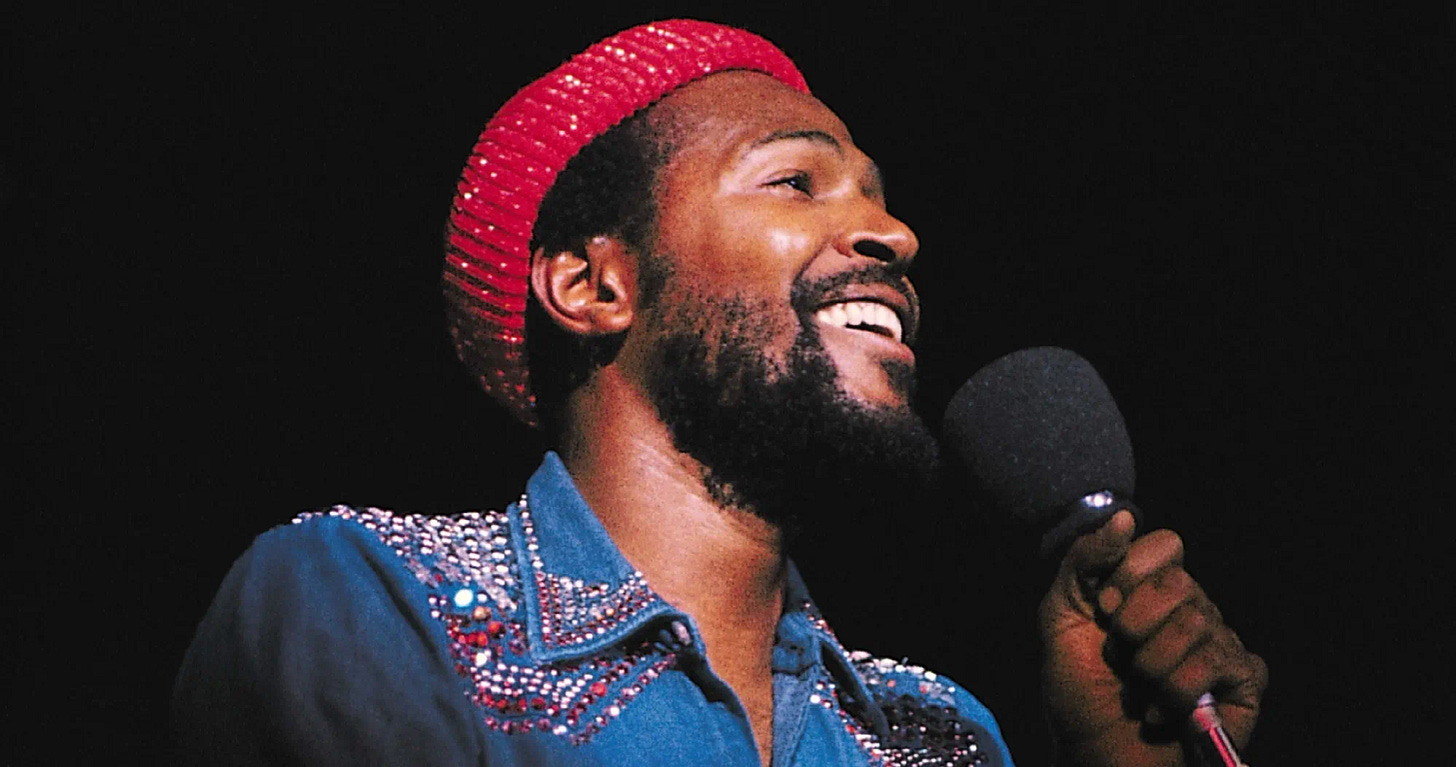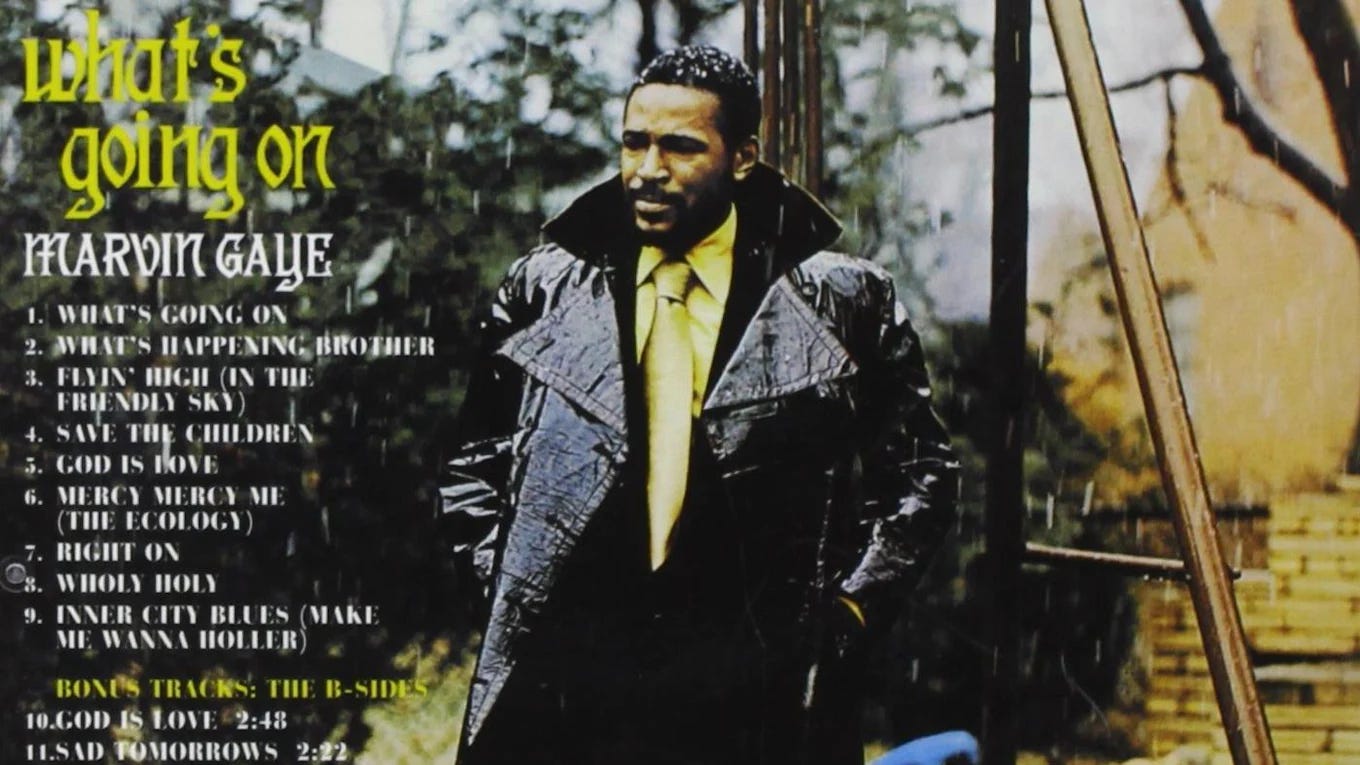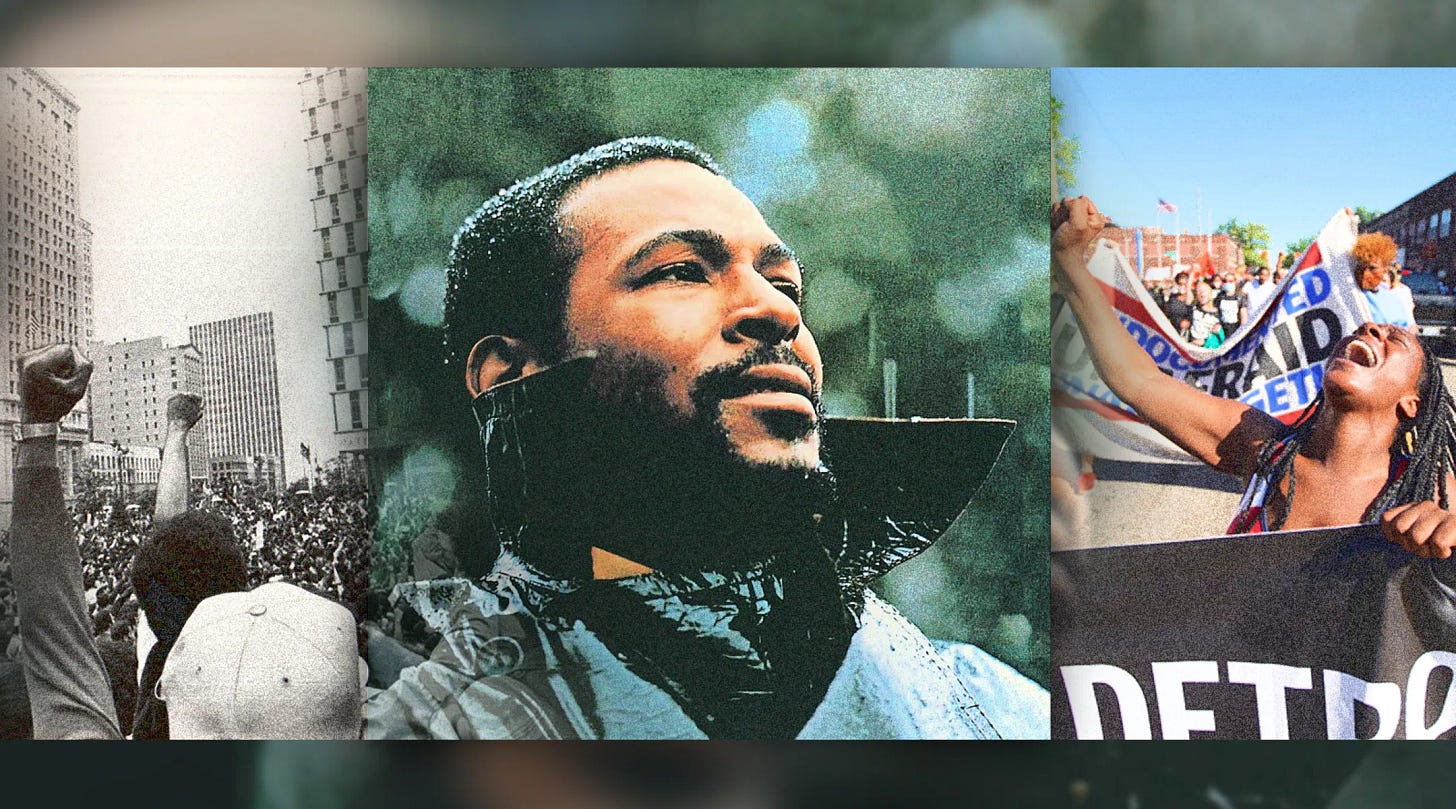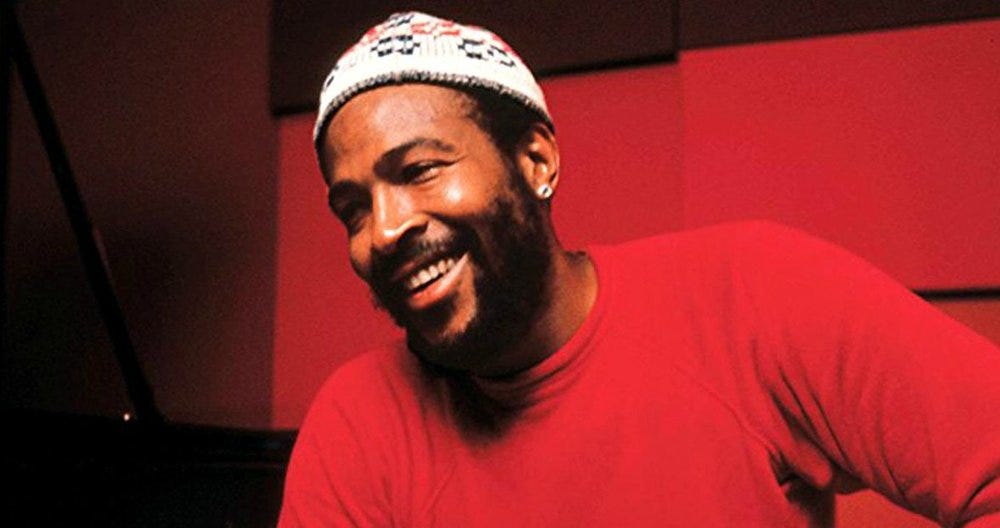*Note to The Vestibule’s subscribers: I wrote this tribute to Marvin Gaye’s exceptional album What’s Going On in October 2021 to celebrate its 50th anniversary. I didn’t have a specific publication or website in mind, although I undoubtedly assumed I could place it somewhere, anywhere, once I polished the piece to a fine finish.
Then, for reasons I can’t precisely explain or recall, I simply let this essay lie. Academic sabbaticals sometimes encourage one (by “one” I mean “me”) to pursue enjoyable projects without regard for their final home, but, in this case, I was either too busy or too lazy—or both!—to find this article an outlet.
I heard “What’s Going On” (the title track) last week while lunching at Union Loafers in St. Louis, Missouri’s Botanical Heights neighborhood, which reminded me of this article’s existence. I dug it out of my hard drive and present it to you, here and now, six months into 2022 and many months after What’s Going On’s 50th anniversary.
“Better late than never” is the cliché (or adage—yes, let’s call it an adage) I’ll invoke to bring this little note to a close. Please determine for yourselves how finely polished this piece is, as well as how worthy of Marvin Gaye’s memory it may be.
—All the best, Jason

1. What’s Up?
Whenever I hear the opening strains of “What’s Going On,” the title song from Marvin Gaye’s incomparable 1971 album, I stop whatever I’m doing to let it (and, often, the entire record) play to completion. “What’s Going On” remains, for me (as for so many of its admirers), one of the greatest singles ever written by an American. This superlative also applies to What’s Going On as a whole, making it a notable achievement in Gaye’s long and distinguished career.
What’s Going On celebrated its 50th anniversary in 2021, although celebrate may be the wrong verb to employ when considering how little the themes, issues, and laments this album chronicles have changed during the intervening half-century.
When phrased this way, such dismal commentary strikes the wrong tenor. No, my intention is to applaud Gaye for composing such an urgent and splendid work of art, yet my attempts to ignore the gloomy thoughts that it provokes—ideas that niggle and jiggle and burrow their way through my consciousness as Gaye’s masterpiece unfolds over nine tracks—almost always fail.
These songs resonate differently now than they did before COVID-19, causing me to ask myself, the last time “What’s Going On” played over the car radio, “Can we really have made so little progress?” This same thought occurred when, later that day, I listened to the rest of the album. What’s Going On, released on 21 May 1971, offered a bracing challenge as 2021 came to a close, a provocation that refuses to diminish or disappear as 2022 reaches its midpoint: Have we travelled so far, only to find ourselves back where we started?
This pessimism is no doubt unwarranted, just a dash of pandemic fatigue marring my otherwise happy sabbatical from university teaching, so, to shake off the cloak of cynicism threatening to envelop me, I listened to What’s Going On last week after hearing the title track (yet again) while lunching at one of my favorite local eateries.
That experience was so unexpected that the differences are worth reporting here. This time, Marvin Gaye’s genius for songwriting and social observation came to the fore (even if the subjects What’s Going On tackles aren’t pleasant to consider). Gaye’s world was so rife with venomous racism, political sclerosis, and environmental cataclysm that he devoted his best album to narrating, in haunting terms, its perils and promise. Their eerie similarities to our present decade’s manias and malaises evoked emotions that, like a rolling tide, broke evenly toward the shores of desperation and inspiration.
Gaye expresses these melancholy paradoxes in his lyrics, yet his voice—venturing over an astonishing range of tones, tempers, and octaves—dramatizes their contradictory events and difficult feelings so well that you needn’t listen to every word to get the message: We’d better start caring for each other regardless of circumstances if we wish to experience lives worthy of the gift that living represents.

The opening number beautifully tracks Gaye’s voice as it moves from warbling falsettos to gushing baritones, sometimes in the space of a single measure, to implore its audience to “find a way / To bring some lovin’ here today.”
More notable, however, is Gaye’s lead-up to this plea, whose call for mutual understanding comes at the end of a verse that melds the personal with the political:
Mother, Mother,
There’s too many of you crying.
Brother, Brother, Brother,
There’s far too many of you dying.
You know we’ve got to find a way
To bring some lovin’ here today, yeah . . .
These supplications bring to mind not only the millions of people lost to COVID-19 whose names I’ll never know but also the hundreds (even thousands) of fellow citizens whose names I’ve learned too late: Ahmaud Arbery, Sandra Bland, Michael Brown, Philando Castile, Michelle Cusseaux, Deborah Danner, George Floyd, Freddie Gray Jr., Marnay Haynes, Botham Jean, Atatiana Jefferson, Natasha McKenna, Tamir Rice, Breonna Taylor, Delaina Ashley Yuan, Trayvon Martin, and on and on (and on)—a list so long it makes me want to weep.
Gaye’s voice wobbles slightly when finishing “too many of you dying” before he inhales to deliver “You know we’ve got to find a way” in a crescendo of perfect phrasing that, precise yet casual, rivals Frank Sinatra in accuracy while outdoing Ol’ Blue Eyes, by miles, in empathy and compassion. Gaye launches “What’s Going On” (the song) with this verse, but doesn’t begin crooning until an initial cacophony of voices asking “Brother, what’s happening?” and “Hey, how you doing?” fade onto the soundtrack, creating the “aural-lusion” that Gaye stands on a street corner taking the pulse of just another day in the life of a nation more divided than united.
This lyrical gambit also plunges the song into the themes of public death and political decay that recur throughout the album. Gaye the master entertainer refuses to regard entertainment as mindless schmaltz lapped up by the unthinking masses, so he pursues a deeper project, one that offers opportunities to reconsider—openly, curiously, and lovingly—the tumult he sees all around us. Gaye, as the album’s generous host and gentle narrator, invites his audience to ponder these perplexities alongside him, providing the twin balms of his luxuriant voice and his band’s superb instrumentals to comfort the weary, or, put another way, to salve the consciences of audience members who make the effort that Gaye encourages.

2. What’s Happening?
The second verse, addressed to “Father, Father,” builds upon these themes by telling the narrator’s unnamed patriarch that “war is not the answer,” a lament that might refer only to personal tensions within their filial relationship, but that suggests Gaye’s engagement with his era’s chief political flashpoint: America’s involvement in Vietnam and this conflict’s domestic ramifications. The third verse brings these submerged tensions to the surface without fanfare or fear:
Picket lines (Sister)
And picket signs (Sister)
Don’t punish me with brutality (Sister)
Talk to me (Sister)
So you can see (Sister)
Oh, what’s going on (What’s going on)
What’s going on (What’s going on)
Yeah, what’s going on (What’s going on)
Oh, what’s going on (What’s going on)
Repeating the song’s (and album’s) title this way grants it almost totemic power, which helps explain, for the curious, why the album’s printed version of this everyday phrase doesn’t end with a question mark. “What’s Going On” may interrogate the pressing issues of Gaye’s time—Vietnam, police brutality, racial strife, economic stagnation, and labor unrest—but neither the song nor its title is a traditional interrogatory. They are, instead, invitations to look around, to see events clearly, and to understand—without blinders or biases—what’s happening.
Sound familiar? I thought so, too. The album’s multitudes renew my admiration for Gaye’s talent at stitching words into vivid, beautiful tapestries that transform his insights into vital, living art. “What’s Going On” and What’s Going On resonate so profoundly because they understand that America’s discordant civic life is nothing new, which requires us to embrace curiosity, compassion, and connection if we hope to improve the lives of others (and improve our own lives, too).
Five decades after What’s Going On hit record stores and radio stations around the country, Gaye’s skillful writing reminds me that love conquers hate not out of naïve hope for a vaguely defined better future lurking just over the horizon, but out of sheer human sympathy for the people who live on this small planet with us.
What’s Going On holds out the tantalizing possibility that, with small changes of perspective, we might grow to respect one another and, perhaps, honor one another no matter our differences. That’s the viewpoint of a mature man who, confronting the fractious realities of this hostile world head-on, clings to his faith that better days are possible if we’re willing to work for them.

The eight tracks that follow “What’s Going On” continue its compelling and coherent story, qualifying What’s Going On as the 1970s’ concept album (or song cycle) par excellence. In literary terms, What’s Going On resembles a novel more than a short-story anthology. Filling albums with songs that weren’t linked in any way had been the norm for American popular music since the 1930s, a model that Berry Gordy’s Motown Records had perfected in the years after its 1959 founding.
Motown began nurturing Gaye’s talent in 1960 and was crucial in his rise to fame, explaining why Gordy was wary about What’s Going On’s commercial chances in a market that preferred one-off tunes that radio stations could play in any sequence they wished. Who needed an artsy-fartsy passion project that aspired to moral, social, and intellectual seriousness (or, worse, that preached political messages to its audience) when Motown had developed a winning (and profitable) formula that worked (almost) every time?
Gaye deliberately (and thankfully) fumbled this formula to produce tracks of such quality that every one’s now a classic. Track #2, “What’s Happening Brother,” continues its predecessor’s subversion of patriotic pieties by plaintively stating, “War is hell / When will it end?,” “Can’t find no work / Can’t find no job,” and “Say man, I just don’t understand / What’s going on across this land.”
Track #3, “Flyin’ High (in the Friendly Sky),” anatomizes the brief joys and terrible costs of heroin addiction, with its opening lines “Flyin’ high in the friendly sky (Flyin’ high) / Without ever leaving the ground (No-o-o-o)” mournfully presaging the narrator’s bleak appraisal of his own depressions and defeats. Track #4, “Save the Children,” hears Gaye cajoling his listeners, in spoken-word cadences, to “save the babies” after asking, “Who really cares to save a world in despair?” and “Who’s willing to try to save a world that’s destined to die?”
Track #5, “God Is Love,” brings Gaye’s religious faith firmly into focus, marking a turning point in What’s Going On’s narrative of national strife and personal decline, with Gaye’s voice caressing the words “God is my friend” before rising to genuine ecstasy when singing “And when we call on Him / For ‘Mercy, Father!’ / He’ll be merciful, my Friend!”
Then comes Track #6, “Mercy Mercy Me (The Ecology),” What’s Going On’s second most-famous tune, the only song on the album solely written by Gaye, and a single that spotlights, in only four minutes, the environmental catastrophes of “fish full of mercury,” “radiation underground and in the sky,” and “poison in the wind that blows from the north and south and east.” This description may make “Mercy Mercy Me” seem didactic, but Gaye’s tender voice bops alongside its brisk percussive tempo, helping his green messages go down like sweet butter melting in one’s mouth (or, in this case, one’s ears).

3. What’s Going On?
What’s Going On concludes with perhaps my favorite track of the album, although selecting only one is a losing proposition since they’re all so good. Even so, “Inner City Blues (Make Me Wanna Holler)” is an elegy that casts America as a country of insuperable contradictions, one that flings men to the moon yet ignores citizens down on their luck, that prioritizes money over all else, and that sends “that boy off to die” while “bills pile up sky high.” When Gaye, who glides over the early lines in a loose and carefree way, switches gears to syncopation, “Inner City Blues” attains a formal and vocal brilliance that’s impossible to resist:
Oh, crime IS
In-CREAS-ing
TRIG-ger HAP-py
Po-LI-cing
PA-nic
Is SPREAD-ing
GOD knows where
We’re HEAD-ing
Oh, make me wanna holler
They don’t understand . . .
Gaye then reprises lines from “What’s Going On” to bring What’s Going On home:
Mother, Mother,
Everybody thinks we’re wrong (Mother, Mother).
Who are they to judge us (Mother, Mother)
Simply ‘cause we wear our hair long?
This is tough stuff on which to stage the album’s conclusion, but fabulous nonetheless. Gaye lets no one—including himself and his listeners—off the political hook in sounding what amounts to a dirge for common men and women all over the United States (and, in truth, all over the world).
Gaye, of course, didn’t create What’s Going On alone or in a vacuum. He had five co-writers on its various tracks (Renaldo “Obie” Benson, Al Cleveland, James Nyx Jr., Elgie Stover, and Gaye’s then-wife—and Berry Gordy’s sister—Anna Gordy Gaye). The session players selected by Gaye are so good that their contributions cannot be praised highly enough. Saxophonist Eli Fontaine’s now-famous opening riff for “What’s Going On” was, according to legend, simply Fontaine goofing off while recording what he thought was a demo, only to have Gaye use it as the song’s (and, thus, the album’s) opening chords.

The tensions between Gaye and Berry Gordy when Gaye first played “What’s Going On” for his boss could fill a short book, so even if Gordy did call the song “the worst thing I ever heard in my life,” as music journalist Dorian Lynskey alleges in his book 33 Revolutions Per Minute,1 we should be thankful that the specter of gargantuan profits prodded Gordy to change his attitude.
In January 1971, Motown executives Barney Ales and Harry Balk—without Gordy’s knowledge or approval—sent 100,000 copies of “What’s Going On” to record stores across America, after which it became the label’s fastest-selling single. Gordy eventually permitted Gaye to do whatever he wanted with What’s Going On, in essence ceding full creative control of the album to his star performer.2
What’s Going On was chosen to head the list of “100 Best Albums Ever” in a 1997 critics’ poll conducted by the Guardian newspaper and, before that, voted “Best Album of All Time” by the writers of a 1985 issue of New Music Express magazine. These accolades, however, are less important than the sheer magnificence of What’s Going On, Marvin Gaye’s eleventh studio album and, I contend, a signature triumph of American art.
Fifty years on,* What’s Going On is as invigorating, as vibrant, and as necessary as ever. Marvin Gaye and his collaborators struck musical gold in 1971, producing a commercial record that became a forever-relevant masterwork. Not bad for ten days (or so) of effort, so I shall take Gaye’s appeals for greater understanding, kindness, and love not merely as proclamations, but as inspirations, too.
In other words, I’ll try to follow Gaye’s example by keeping my heart and my eyes open, by paying closer attention to the world and the people around me, and by hoping against hope to feel and to hear and to see—with as much grace as I can muster—what’s going on.
NOTES
Dorian Lynskey, 33 Revolutions Per Minute: A History of Protest Songs, from Billie Holiday to Green Day, HarperCollins, 2011, pg. 157.
Richard Buskin, “Marvin Gaye: ‘What’s Going On,’” Sound on Sound, July 2011, https://www.soundonsound.com/techniques/marvin-gaye-whats-going.





